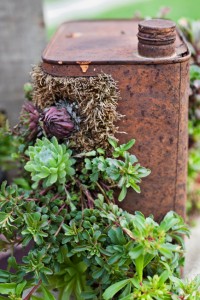
“If you feel guilty throwing aluminum cans or paper in the trash,” the Internet recently told me, “you live in Washington.” As a native Northwesterner, I can personally vouch for this. Yes, we wear sandals with socks; yes, we assume you’re a tourist if you’re carrying an umbrella; and yes, we can be a little fanatical when it comes to the environment. Which is why this Seattle times article from a few years ago, titled “Turn your old junk into garden treasures,” struck a chord in my rainy little heart. Recycling? Gardening?!
And DIY?! Swoon!
Of course, the trend of repurposing rubbish for use in container gardening is hardly brand new. Home and garden magazines have been telling us for years how cute our herbs would look peeking out of old bathtubs and galvanized watering cans. And using containers you already have on hand both reduces waste and saves money. But before you go ransacking the woodshed, here are a few points to consider.
Materials. Growing food in containers requires some extra diligence. According to the University of Louisville’s Center for Environmental Policy & Management, one major consideration in safe container gardening is chemical leaching. Fantastic flea market furniture could contain lead paint; galvanized metals may contain zinc or cadmium; and even salvaged lumber has sometimes been treated with creosote or asbestos. Additionally, the container’s color can affect soil temperature (darker = hotter), which might harm small shoots. And materials not meant for outdoor use could break, rot, or dry out.
 Size
Size. Yes, your husband’s collection of Scooby Doo lunch boxes could be put to better use than taking up space in the coat closet. However, a tall tomato or deep carrot won’t really thrive in something so shallow. Consider the size and depth of the container in relation to plants’ needs. The University of Maryland’s Home & Garden Information Center offers a handy set of recommendations by plant. (P.S. They also have an ingenious how-to for a self-watering container out of a five gallon bucket!)
Drainage. No matter what container you Replace, be sure it will stand up to a quarter inch drill bit. Proper drainage is crucial and can get tricky with containers not originally meant for garden use. Drill, poke, or punch enough holes to allow for quick drainage; consider lining the bottom of the container with gravel; and, if possible, mount the container on blocks—even one or two inches is better than setting it flush on flat ground.
So, even if you’re not the sock-with-sandals, guilt-ridden-because-you-threw-paper-away type, think carefully before making that next dump run. And if you think that “reduce, reuse, recycle” needs to be your new gardening mantra, here are a few other ideas to make your greens even greener. Look for later posts on these!
- Seed harvesting
- Natural pest deterrents
- Foraging for mushrooms and edible weeds
- Sprouting beans and seeds
- Re-growing from kitchen scraps

 Size. Yes, your husband’s collection of Scooby Doo lunch boxes could be put to better use than taking up space in the coat closet. However, a tall tomato or deep carrot won’t really thrive in something so shallow. Consider the size and depth of the container in relation to plants’ needs. The University of Maryland’s Home & Garden Information Center offers a handy set of recommendations by plant. (P.S. They also have an ingenious how-to for a self-watering container out of a five gallon bucket!)
Drainage. No matter what container you Replace, be sure it will stand up to a quarter inch drill bit. Proper drainage is crucial and can get tricky with containers not originally meant for garden use. Drill, poke, or punch enough holes to allow for quick drainage; consider lining the bottom of the container with gravel; and, if possible, mount the container on blocks—even one or two inches is better than setting it flush on flat ground.
So, even if you’re not the sock-with-sandals, guilt-ridden-because-you-threw-paper-away type, think carefully before making that next dump run. And if you think that “reduce, reuse, recycle” needs to be your new gardening mantra, here are a few other ideas to make your greens even greener. Look for later posts on these!
Size. Yes, your husband’s collection of Scooby Doo lunch boxes could be put to better use than taking up space in the coat closet. However, a tall tomato or deep carrot won’t really thrive in something so shallow. Consider the size and depth of the container in relation to plants’ needs. The University of Maryland’s Home & Garden Information Center offers a handy set of recommendations by plant. (P.S. They also have an ingenious how-to for a self-watering container out of a five gallon bucket!)
Drainage. No matter what container you Replace, be sure it will stand up to a quarter inch drill bit. Proper drainage is crucial and can get tricky with containers not originally meant for garden use. Drill, poke, or punch enough holes to allow for quick drainage; consider lining the bottom of the container with gravel; and, if possible, mount the container on blocks—even one or two inches is better than setting it flush on flat ground.
So, even if you’re not the sock-with-sandals, guilt-ridden-because-you-threw-paper-away type, think carefully before making that next dump run. And if you think that “reduce, reuse, recycle” needs to be your new gardening mantra, here are a few other ideas to make your greens even greener. Look for later posts on these!

